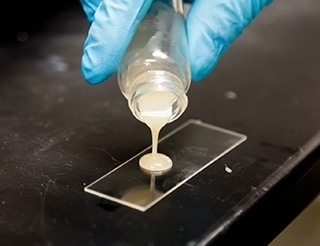Mar 14 2016
Ice is considered a nuisance on a car’s windshield, but it is dangerous on an airplane, a ship, oil rig, a wind turbine, or a power line. While methods like hammers, scrapers or chemical melting agents are often used to remove ice, these are labor-intensive, complicated, and costly processes.

Researchers at the University of Michigan have developed an ice repellent coating that is set to change the traditional ice-removing methods. The new coating is transparent, thin, and somewhat rubbery to the touch, it is also durable and cost-effective. The unique spray-on formula could make the ice slide easily from car windshields, airplanes, and equipment, with the aid of a mild breeze or gravitational force. This latest development has potential applications in transportation, shipping and energy sectors, where ice presents a constant issue in cold environments.
The novel ice repellent coating could also help to save a considerable amount of energy in freezers, which presently depend on energy-hungry and complicated defrosting systems to remain frost-free. The coating could provide the same results with zero energy usage, making freezers used for residential and industrial purposes by as much as 20% more efficient. The study has been described in a paper published in the Science Advances journal. The paper is titled, “Designing Durable Icephobic Surfaces.”
The previous icephobic coating techniques depended on making the surfaces very slippery or water resistant, however the latest spray-on formula, developed from a combination of standard artificial rubbers, represents a departure from these approaches.
Icephobic Coating
University of Michigan researchers demonstrate a durable ice-repellent coating that could help keep everything from airplanes to ships, power lines and windshields ice-free.
Researchers had been trying for years to dial down ice adhesion strength with chemistry, making more and more water-repellent surfaces. We’ve discovered a new knob to turn, using physics to change the mechanics of how ice breaks free from a surface.
Kevin Golovin, Materials Science and Engineering Graduate Student, University of Michigan
Anish Tuteja, U-M Materials Science and Engineering associate professor, headed the study. Under Tuteja’s guidance, the researchers initially worked with water-resistant surfaces and concluded that they were not effective at removing ice. However during the course of the experiments, they discovered that rubbery coatings that do not repel water were still able to repel ice effectively. The team later discovered that water-shedding ability was not an important factor, and that the rubbery coatings were able to repel ice because of a unique phenomenon known as interfacial cavitation.
Golovin explained that two stiff surfaces (for example the car windshield and ice) will firmly bind together, so a considerable amount of force is needed to break this bond. However, due to interfacial cavitation, a solid material that was adhered to a rubbery surface would behave in a different manner. This rubbery surface would be easily deformed by applying a minimal force, breaking the solid free.
Nobody had explored the idea that rubberiness can reduce ice adhesion. Ice is frozen water, so people assumed that ice repelling surfaces had to also repel water. That was very limiting.
Anish Tuteja, Associate Professor of Materials Science and Engineering, University of Michigan
With this latest method, the durability of the coating can be greatly improved compared to the earlier icephobic coatings, which depended on delicate materials that lose their ability to shed ice following just a few freeze-thaw cycles. In contrast, the new coatings stood up to a range of laboratory tests such as mechanical abrasion, salt spray corrosion, peel tests, high temperatures, and a countless number of freeze-thaw cycles.
The researchers also noticed that when the coating’s rubberiness and smoothness are slightly changed, the level of durability and ice repellency can be further fine-tuned. While softer surfaces have been found to repel ice much more efficiently they are less durable, but in the case of harder coatings, the opposite is true. According to Golovin, that kind of flexibility will allow the team to develop coatings to suit a wide range of applications.
An airplane coating, for example, would need to be extremely durable, but it could be less ice-repellent because of high winds and vibration that would help push ice off. A freezer coating, on the other hand, could be less durable, but would need to shed ice with just the force of gravity and slight vibrations. The great thing about our approach is that it’s easy to fine-tune it for any given application.
Kevin Golovin, Materials Science and Engineering Graduate Student, University of Michigan
The researchers have already developed hundreds of ice-repelling formulas. Some are smooth to the touch, some are rough, and some have the ability to shed water, while others don't. However these formulas all share a common feature: ice easily slides off.
I think the first commercial application will be in linings for commercial frozen food packaging, where sticking is often a problem. We’ll probably see that within the next year. Using this technology in places like cars and airplanes will be very complex because of the stringent durability and safety requirements, but we’re working on it.
Anish Tuteja, Associate Professor of Materials Science and Engineering, University of Michigan
The U-M MTRAC program provided funds and assistance to the research team. The program was established to support latest innovations that are commercially viable. MTRAC is supported in partnership with the Entrepreneur and Innovation initiative of the Michigan Economic Development Corporation. This initiative was launched to establish Michigan as a development hub to grow business prospects by offering start-up firms to access a wide range of resources.
The National Science Foundation, the Air Force Office of Scientific Research, the Office of Naval Research, and the Nanomanufacturing Program (grant number 1351412) funded the study.